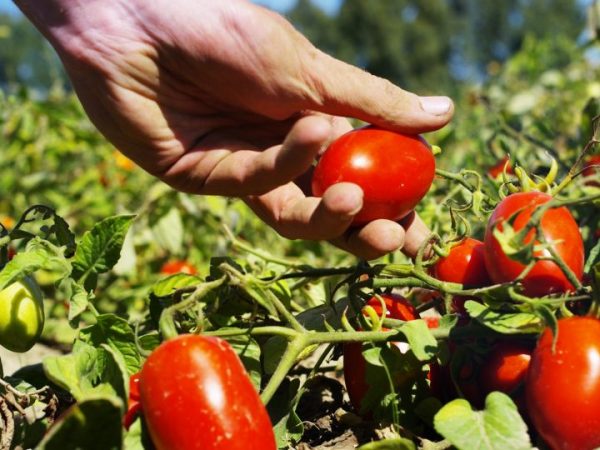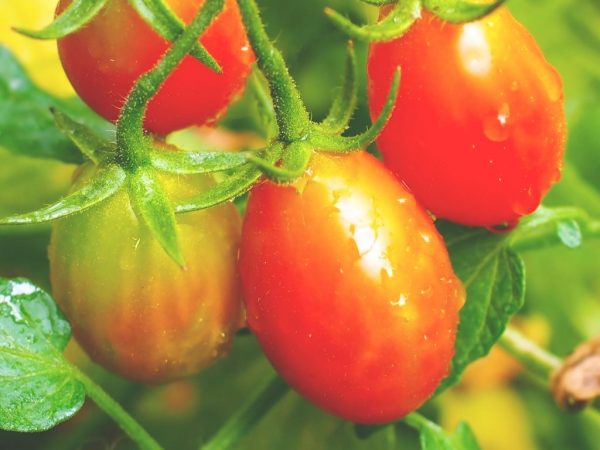Description of tomato cream
There are many different types of tomatoes, each of them differs from each other in its characteristics and qualities and, most importantly, in yield. Tomato Slivovka is a relatively new and interesting species that was created through hybridization.

Description of tomato Plum
Description of the variety
Tomatoes of this type grow low, about 40-45 cm. They are classified as determinant tomato varieties. The fruits are rounded and slightly oblong in structure, somewhat reminiscent of small zucchini. They are also often compared to plums because of their shape, and it is from this that the name Slivovka comes from. The fruits are always only red, rich and ruddy. The total weight of one fruit usually ranges from 75 grams. and up to 110 gr. The very first fruits will be the largest, and then, when the bush grows, there will be more fruits, but their mass will change slightly.
Tomatoes show good yields, up to 10 kg are obtained from 1 bush. The variety is considered universal, therefore the fruits are also used for fresh use, in the same way it is suitable for conservation, and tomato, and dressing. Often one bush is 2-3 stems, but most often only 2 are used. It can be planted in open ground, the soil for this variety is not important.
This type of variety is perfect for those gardeners who have never dealt with this type of seedlings before. Tomatoes are unpretentious, any type of soil will suit them, the most important thing is to water the plant on time.
Positive aspects of the variety
Absolutely any plant has its positive and negative sides. Rarely, negative aspects of this species are noticed. And, if you believe the reviews of many gardeners, there are none at all.
The positive aspects are presented below.
- The fruits are distinguished by their versatility, ripen well and grow to medium size. They have a pleasant and rich taste. Someone says that this is a sweet taste with sourness, someone else says that the variety is generally sweet.
- Interesting and attractive external characteristics, excellent appearance, which gives a big plus to the variety Slivovka.
- A significant plus is that this variety has good results in terms of yield.
- Due to the fact that the variety was bred artificially, it has excellent resistance to diseases and pests, they rarely get sick, so you will not have any problems with this. The bushes are durable, the main thing is to take care of them.
- The fruits ripen very quickly and from their color (red) it becomes clear that they are ripe.
- Varietal qualities are excellent.

The fruits of this variety can withstand long-term storage.
The positive aspects include the fact that a tomato of this type can be stored for a very long time, the main thing is to withstand all storage standards. They should lie in wooden boxes, preferably with newspaper between each layer, and of course moisture and temperature should be taken into account. According to the gardeners' reviews, it is clear that such a variety can lie until the New Year.
Negative points
The description of the variety demonstrates that tomatoes have some disadvantages. Sometimes there are situations when the seedling does not grow.This happens very rarely, and most often due to the fact that he is simply "naughty." Perhaps he did not like the very fact that he was transported and planted from one conditions and soil to another. In this case, the bush will either simply grow poorly at first, or it will completely die. It is then that it is necessary to intensively give fertilizer and humus, add calcium and watering.
Despite such a minus, such situations are rare. The root system of tomatoes has good firmness. They can withstand both severe frosts and severe drought, but then one can hardly expect good yields from them.
Planting rules of the variety
Most experts advise to carry out the sowing stage 30-33 days before the first warm times. That is, it is best to do this in early spring, but when there is no longer any frost. You can plant 3-4 pieces per m². seeds, but no more. This can lead to the fact that the roots will not grow properly and, as a result, will not take the necessary vitamins from the soil and then you will not get a good harvest.
And of course, the most important rule is to fertilize the soil before you plant the plant. First, the site must be dug up, and then only fertilized. Basically, as mentioned earlier, a plant can live and flourish in any soil.
Growing and harvesting yields
Often, the planting of tomatoes falls at the beginning of March and the end of April. 2 stems are left on one plant, sometimes 3, but this phenomenon is very rare. Also, the bush must be tied up when it has a ripening peak, the fruits will gain their mass and break the branches.
After 50-60 days you will be able to harvest the first crop and taste the variety. It has never been noticed that any disease has attacked the plant. This is a high grade tomato. On average, you can get up to 6-8 kg from one bush. Sometimes it can bear fruit up to 10 kg, but usually this only happens if the bush is young and this was his first crop of tomatoes. Water the plant immediately on the first day of harvest.


